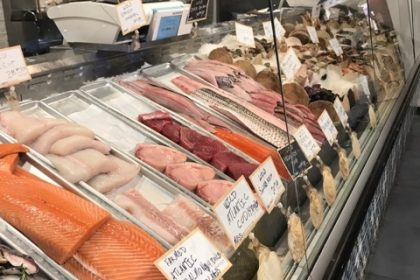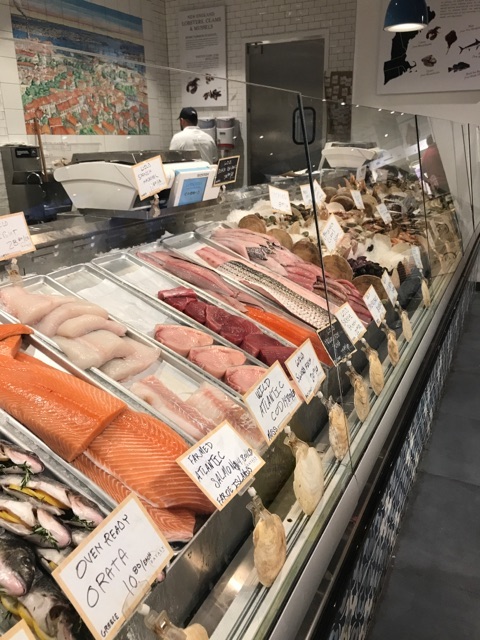
This piece was originally posted by Sarah Schumann on September 18, 2017 on the Eating with the Ecosystem blog.
 New England fisheries are at a crossroads. This heritage industry, which has provided livelihoods for so many for so long in our region, now finds itself challenged by a changing and unpredictable natural environment, an increasingly cutthroat global marketplace, shifts in demographics and public attitudes, and above all, a bulging regulatory burden that often reacts to one problem at a time and limits the adaptive space available to fishermen as they strive for resilience.
New England fisheries are at a crossroads. This heritage industry, which has provided livelihoods for so many for so long in our region, now finds itself challenged by a changing and unpredictable natural environment, an increasingly cutthroat global marketplace, shifts in demographics and public attitudes, and above all, a bulging regulatory burden that often reacts to one problem at a time and limits the adaptive space available to fishermen as they strive for resilience.
For the past year, Eating with the Ecosystem has been participating in the Food Solutions New England network. Food Solutions New England is a regional, collaborative network organized to support the emergence and continued viability of a New England food system that is a resilient driver of healthy food for all, racial equity, sustainable farming and fishing, and thriving communities.
A food system is defined as “all those activities involving the production, processing, transport and consumption of food, [including] the governance and economics of food production, its sustainability, the degree to which we waste food, and how food production affects the natural environment[1].”
Eating with the Ecosystem is participating in Food Solutions New England because we believe that a food systems approach has tremendous value for New England fisheries. Here are five reasons why:
1. Governance, not just government
Compared to other parts of our food system, the wellbeing of fisheries is disproportionately affected by formal government regulatory processes. Fisheries management mechanisms such as licensing, open and closed seasons, legal sizes, individual and group quotas, and others determine who can fish, when and where they can fish, what gear they can use, and how much they can catch. Because of its overarching influence, formal fisheries management has long been the primary lever that fishermen, their allies, and adversaries try to pull in order to influence their future. But this emphasis on formal government decision-making – as opposed to the broader concept of governance – misses a large part of the potential field of action available to these actors as they try to shape a future for New England fisheries.
“Governance is the sum of the many ways individuals and institutions, public and private, influence their common affairs. It is a continuing process through which conflicting or diverse interests may be accommodated and co-operative action may be taken. It includes formal institutions and regimes empowered to enforce compliance, as well as informal arrangements that people and institutions either have agreed to or perceive to be in their interest[2].”
In fisheries, governance can include consumers, wholesalers, retailers, fish workers, educators, chefs, and policy makers outside of the fisheries management process. Each of these actors can provide skills, connections, and spaces for interaction that can support regional fisheries in new ways that complement the role of government management. Food systems work innately includes the full governance spectrum; by enhancing the integration of fisheries into food systems work and vice-versa, fisheries can benefit from these forms of thinking and acting.
2. Defining societal goals and values
The public tends to be distanced from the decisions that shape fisheries. Fisheries are isolated by their geographic marginalization (i.e., their activities take place on the land’s margins and at sea, not interspersed with human settlements like farms) and the arcane nature of fisheries science and management. Ironically, the public tends to feel much closer to farming – an activity that takes place on private land – than it does to fishing – an activity that takes place in public waters and harvests publicly owned and managed resources.
A coherent regional public vision for fisheries would strengthen the values basis for decisions about the future of our ports and working waterfronts, regulations on harvest and sale of seafood, and many others. It would help guide fisheries management, especially as it moves from narrow piecemeal approaches that manage individual species to a more holistic, ecosystem-based framework called Ecosystem Based Fisheries Management (EBFM) that manages the whole ecological system – a process that is currently underway but that lacks a north star.
Additionally, food can give the public a more meaningful role in decision-making and can help overcome historical tensions between the fishing community and the environmental community in New England fisheries. It can help members of the public view themselves as stakeholders and ultimately bring greater transparency and democratic participation to fisheries management decisions.
3. A vision for the Anthropocene
Marine ecosystems are highly dynamic and adaptive, responding on a continuous basis to food web fluxes, natural climate cycles, fishing activity, and increasingly, manmade climate change. But many in the sustainability movement have applied a preservationist lens to fisheries, attempting to sustain a static ecosystem configuration free of human influence. This objective is misapplied for two reasons: first, marine ecosystems are not static, and second, they are not free from human influence. What, then, should be the benchmark by which we evaluate fisheries? This is an open question that will become increasingly important in the coming years. But one concept – the “Anthropocene” – may provide a roadmap.
In After Nature: A Politics for the Anthropocene, Jedediah Purdy singled out the food movement as the best example of an Anthropocene social movement. In “The New Nature”, he writes:
If we embrace not just the Anthropocene condition but also the insight—if we accept that there is no boundary between nature and human action and that nature therefore cannot provide a boundary around contestation—we may have the basis of a democratic future…
The food movement provides a possible model of the next politics of nature. If the old vision of nature was one of wilderness and the pristine, which assumes the separateness of humans and nature, the new one might be agriculture, which emphasizes how the constant, inescapable metabolism between humans and the rest of the world shapes both…[3]
4. Replacing end-of-pipeline approaches with positive feedback loops
Until now, both government- and consumer-led efforts to promote sustainability of marine ecosystems and their resources have focused almost entirely on controlling the actions of end users: the fishermen who harvest seafood. This end-of-the-pipeline focus misses many other things that affect the production of wild seafood, perhaps most notably the habitat base that provides refuge, sustenance, and other services to the animals that inhabit our rivers, coasts, and oceans – and that eventually become our seafood. Government fisheries management is ill equipped to deal with upstream factors affecting seafood because, by law,[4] its purview is limited to regulating seafood harvests. While some aspects of fisheries habitat do come under government decision making, this is largely through other (non-fisheries) processes such as land use and waterway planning, water quality management, energy planning, mining permits, etc. – in other words, decision processes that are not linked to the production of wild seafood as a social goal.
A food systems approach can help by engineering positive feedback loops between the enjoyment of wild seafood and participation in seafood habitat advocacy. Crafting these feedback loops requires education and democratic activation of seafood consumers, as well as the charting of pathways to support seafood habitat through local land use planning processes, water quality work, marine spatial planning, and other arenas outside fisheries management. A food systems approach can lay the bedrock for these pathways.
The same logic applies to the socio-economic underpinnings of fisheries. In a region where seafood consumers far outnumber seafood producers, it is important to strengthen connections between the public and fisheries practitioners and to give consumers the education and tools they need to become fisheries constituents. In this vision, the flow of food through the food system is accompanied by a flow of information and political will that feed back into the goal of sustaining regional fisheries for the public good. Priming and activating these linkages can bring greater transparency to the seafood system and greater social support for fisheries and the people who practice them.
5. Achieving business-level viability
Until the 1990s, the emphasis in fisheries management and economics was on building up fleets to harvest greater quantities of seafood. Since the 1990s, the emphasis in many fisheries has been on downsizing fleets and reducing harvests, often through means that reduce the viability of individual businesses and the resilience of the fisheries system. There is a need now for a third approach that focuses on enhancing viability and resilience within a steady-state resource economy by diversifying incomes and opportunities, providing social support through waterfront and fisheries access, and reducing regulatory red tape and inefficiencies that hamper business-level adaptation.
The food system is a set of nested systems where viability of the components (i.e., individual businesses) contributes to the performance of the whole. The farm viability approach employed by food systems practitioners to understand and support farms within the New England region and beyond is a valuable model that should be applied in greater measure to fisheries. Viability of individual businesses is affected by systemic issues. Critical issues such as obstacles to new entry, low levels of participation by young people, issues and costs of waterfront access, global and local market forces, and the increasing costs of regulatory compliance (e.g., at-sea monitors, permits, etc.) are areas that can benefit from a viability approach.
Learn more
Explore Food Solutions New England’s website to learn more about this network and its goal to obtain 50% of the total regional food supply by 2060 from the region’s own coasts and fields.
Sarah Schumann is a fish worker, fisherman, writer, and advocate. She is the founder and Board President of Eating with the Ecosystem, a small non-profit that works to apply the principles of ecosystem science to the New England seafood system and marketplace. She worked with the University of Rhode Island to write the book “Rhode Island’s Shellfish Heritage: An Ecological History,” published in 2015. She was a participant in the first Network Leadership Institute and serves on the Network Team.




